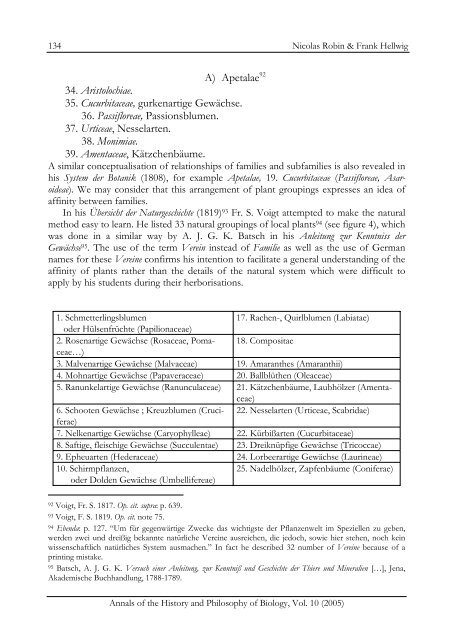Annals of the History and Philosophy of Biology
Annals of the History and Philosophy of Biology
Annals of the History and Philosophy of Biology
Create successful ePaper yourself
Turn your PDF publications into a flip-book with our unique Google optimized e-Paper software.
134<br />
<strong>Annals</strong> <strong>of</strong> <strong>the</strong> <strong>History</strong> <strong>and</strong> <strong>Philosophy</strong> <strong>of</strong> <strong>Biology</strong>, Vol. 10 (2005)<br />
Nicolas Robin & Frank Hellwig<br />
A) Apetalae 92<br />
34. Aristolochiae.<br />
35. Cucurbitaceae, gurkenartige Gewächse.<br />
36. Passifloreae, Passionsblumen.<br />
37. Urticeae, Nesselarten.<br />
38. Monimiae.<br />
39. Amentaceae, Kätzchenbäume.<br />
A similar conceptualisation <strong>of</strong> relationships <strong>of</strong> families <strong>and</strong> subfamilies is also revealed in<br />
his System der Botanik (1808), for example Apetalae, 19. Cucurbitaceae (Passifloreae, Asaroideae).<br />
We may consider that this arrangement <strong>of</strong> plant groupings expresses an idea <strong>of</strong><br />
affinity between families.<br />
In his Übersicht der Naturgeschichte (1819) 93 Fr. S. Voigt attempted to make <strong>the</strong> natural<br />
method easy to learn. He listed 33 natural groupings <strong>of</strong> local plants94 (see figure 4), which<br />
was done in a similar way by A. J. G. K. Batsch in his Anleitung zur Kenntniss der<br />
Gewächse95. The use <strong>of</strong> <strong>the</strong> term Verein instead <strong>of</strong> Familie as well as <strong>the</strong> use <strong>of</strong> German<br />
names for <strong>the</strong>se Vereine confirms his intention to facilitate a general underst<strong>and</strong>ing <strong>of</strong> <strong>the</strong><br />
affinity <strong>of</strong> plants ra<strong>the</strong>r than <strong>the</strong> details <strong>of</strong> <strong>the</strong> natural system which were difficult to<br />
apply by his students during <strong>the</strong>ir herborisations.<br />
1. Schmetterlingsblumen<br />
oder Hülsenfrüchte (Papilionaceae)<br />
17. Rachen-, Quirlblumen (Labiatae)<br />
2. Rosenartige Gewächse (Rosaceae, Pomaceae…)<br />
18. Compositae<br />
3. Malvenartige Gewächse (Malvaceae) 19. Amaran<strong>the</strong>s (Amaranthii)<br />
4. Mohnartige Gewächse (Papaveraceae) 20. Ballblü<strong>the</strong>n (Oleaceae)<br />
5. Ranunkelartige Gewächse (Ranunculaceae) 21. Kätzchenbäume, Laubhölzer (Amentaceae)<br />
6. Schooten Gewächse ; Kreuzblumen (Cruciferae)<br />
22. Nesselarten (Urticeae, Scabridae)<br />
7. Nelkenartige Gewächse (Caryophylleae) 22. Kürbißarten (Cucurbitaceae)<br />
8. Saftige, fleischige Gewächse (Succulentae) 23. Dreiknüpfige Gewächse (Tricoccae)<br />
9. Epheuarten (Hederaceae) 24. Lorbeerartige Gewächse (Laurineae)<br />
10. Schirmpflanzen,<br />
oder Dolden Gewächse (Umbellifereae)<br />
25. Nadelhölzer, Zapfenbäume (Coniferae)<br />
92 Voigt, Fr. S. 1817. Op. cit. supra: p. 639.<br />
93 Voigt, F. S. 1819. Op. cit. note 75.<br />
94 Ebenda: p. 127. “Um für gegenwärtige Zwecke das wichtigste der Pflanzenwelt im Speziellen zu geben,<br />
werden zwei und dreißig bekannte natürliche Vereine ausreichen, die jedoch, sowie hier stehen, noch kein<br />
wissenschaftlich natürliches System ausmachen.” In fact he described 32 number <strong>of</strong> Vereine because <strong>of</strong> a<br />
printing mistake.<br />
95 Batsch, A. J. G. K. Versuch einer Anleitung, zur Kenntniß und Geschichte der Thiere und Mineralien […], Jena,<br />
Akademische Buchh<strong>and</strong>lung, 1788-1789.

















